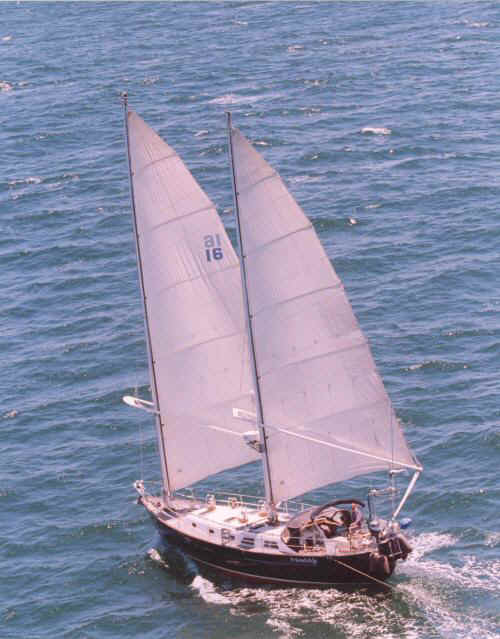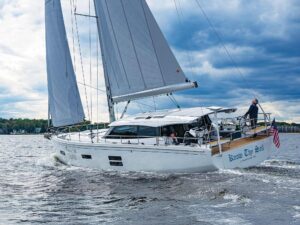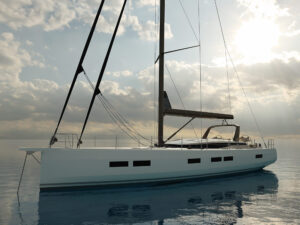
My Avelinda was built in 1982 at the Ta Chiao yard, one of 48 Tanton 43 cat ketches built at various locations in Taiwan over a period of several years. They appear occasionally on the used-boat market on either side of $100,000.
The Tanton 43 has a round stern, which gives the hull something of the appearance of the Valiant 40, but the likeness ends there. The sail area is divided almost equally between the mainsail and mizzen; both of these are set on freestanding carbon-fiber masts with wishbone booms. Handling the sails, therefore, is never overwhelming, even when sailing shorthanded. Tacking requires little more than a turn of the wheel, and the boat tracks so well that I rarely bother with the autopilot. The absence of standing rigging allows the boat effortlessly to sail wing and wing.
High lifelines and 4-inch bulwarks surround the deck. With its long, wide seats and built-in table, the large cockpit provides additional living space, but even with a high bridgedeck and large drains, it’s large for offshore work.
The engine control panel, mounted close to the cockpit sole on the side of the pedestal, is difficult to monitor. Below the waterline, the hull is solid fiberglass, and above it’s balsa-cored. The teak deck was laid on a balsa-cored deck and requires regular maintenance.
Down below is wall-to-wall teak and mahogany. In the bow is a cabin with a V-berth, a bench seat, and a large hanging locker. The saloon seats eight between an L-shaped dinette and the settee opposite. To port is the head with a full shower. The galley-with plenty of counter space, storage, and light-is to starboard.
A 70-horsepower Yanmar is mounted below the centerline galley counter, and removable panels on all sides provide for excellent access. The portside aft cabin has access to the head and to the base of the companionway opposite the nav station. All lockers and floorboards have locks to prevent them opening in a knockdown.
Without wanting to hurt Avelinda’s feelings, I have to admit that she’s not perfect, but I do understand that all boats are a compromise. While I’m happy with how the galley functions, its position between the companionway and the saloon means that it gets a lot of traffic. The nav station is conveniently located at the base of the companionway, but only a shrimp like me can sit without head banging and crouching. Maneuvering in tight quarters can be tricky; the prop is so far forward of the rudder that the boat is slow to respond at low speeds.
The biggest problem I have with my generally wonderful vessel is system overload, given the watermaker, refrigeration, and so on and the 640 amp-hours of batteries it takes to power them. The former owner, an obsessed engineer, rewired, replumbed, and repowered. Instead of drifting off to sleep with Slocum or Moitessier, I find myself reading manuals and Nigel Calder. In the morning when I wake up, the only thing I’m sure that works are the sails. I go sailing.
Nancy Willette started sailing in her teens on a friend’s daysailer. Avelinda is the third boat she’s owned.








